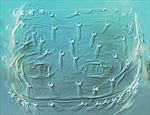Distinguishing features
Female macroptera. Body and legs yellow, abdominal tergites III–VII with pair of small brown areas laterally, III–IV with brown shading medially; antennal segments I–II white, III yellow, IV–V with apex shaded brown, VI–IX brown; fore wings pale. All dorsal setae on head, thorax and fore wings distinctly spatulate; head wider than long, with transverse sculpture behind eyes but ocellar region without sculpture; eyes with 6 pigmented facets; ocellar setae III within triangle. Antennae 9-segmented; II with few microtrichia, 2 dorsal setae weakly spatulate; sense cone simple or weakly forked on III, forked on IV; VI short, constricted at base but not pedicellate; suture oblique between VI–VII. Pronotum with irregular sculpture markings; with no long setae, discal setae spatulate. Metascutum irregularly reticulate; median setae spatulate, on anterior third of sclerite, lateral setae finely setaceous; campaniform sensilla present. Fore wing first vein with setal row irregular, 8–11 setae on basal half, 4–6 on distal half, row sometimes almost continuous; second vein with 12–14 setae including one seta basal to vein fork; clavus with 4–6 veinal setae and one seta at base. Abdominal tergites III–VII with no sculpture medially, median setae closer together than their length; irregular sculpture lines laterally not extending mesad of setae S2; VI–VII with setae S3 as large and spatulate as S4; tergite VIII median setae wide apart, comb with long, slender teeth, lateral setae spatulate; major setae on IX–X pointed.
Male macroptera. Similar to female; tergite VIII with long comb; IX with one pair of short setae medially; sternites without pore plates.
Related species
There are 43 species of Anaphothrips known from Australia (Mound & Masumoto, 2009), out of a total of 86 species worldwide (ThripsWiki, 2020). Many of these species have the antennae clearly 9-segmented, others clearly have only 8 segments, but several species have an intermediate condition with segment VI bearing a partial and often oblique transverse suture. The major setae in both sexes of A. glenysae are more broadly spatulate than in any other member of the genus, including A. exocarpi. In contrast to that species, the eyes have pigmented facets, also the males of A. glenysae have no sternal pore plates and the median setae on tergite IX are short but not stout.
Biological data
Feeding on the leaves of Rhagodia parabolica (Chenopodiaceae), a common shrub in dry areas of eastern and central Australia.
Distribution data
Recorded only from South Australia.
Family name
THRIPIDAE - THRIPINAE
Species name
Anaphothrips glenysae Mound & Masumoto
Original name and synonyms
Anaphothrips glenysae Mound & Masumoto, 2009: 41.
References
Mound LA & Masumoto M (2009) Australian Thripinae of the Anaphothrips genus-group (Thysanoptera), with three new genera and thirty-three new species. Zootaxa 2042: 1–76. http://www.mapress.com/zootaxa/2009/f/zt02042p076.pdf




